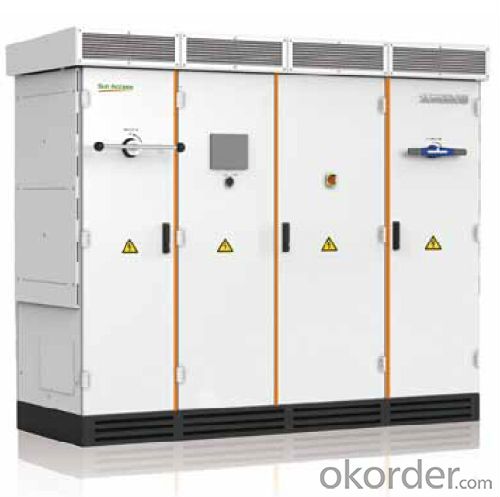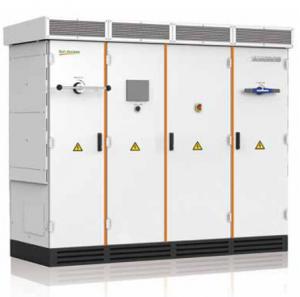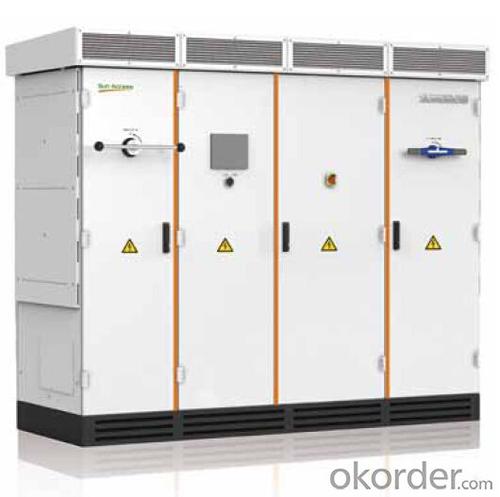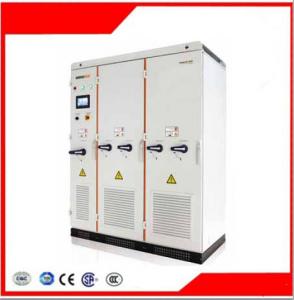PCS Solar Inverter - Photovoltaic Grid-Connected Inverter SG800MX
- Loading Port:
- China Main Port
- Payment Terms:
- TT or LC
- Min Order Qty:
- 50 unit
- Supply Capability:
- 1000 unit/month
OKorder Service Pledge
OKorder Financial Service
You Might Also Like
1. Structure of Photovoltaic Grid-Connected Inverter SG800MX Description
A solar inverter, or PV inverter, or Solar converter, converts the variable direct current (DC) output of a photovoltaic (PV) solar panel into
autility frequency alternating current (AC) that can be fed into a commercial electrical grid or used by a local, off-grid electrical network.
It is acritical BOS–component in a photovoltaic system, allowing the use of ordinary AC-powered equipment. Solar inverters have
special functions adapted for use with photovoltaic arrays, including maximum power point tracking and anti-islanding protection.
Suitable for 50Hz/60Hz grid, could be used in Asia, North America and Europe.
2. Main Features of the Photovoltaic Grid-Connected Inverter SG800MX
• Transformerless inverter, max. efficiency of 98.7%, CEC efficiency of 98.5% for SG800MX,max. efficiency of 98.6%, CEC efficiency of 98.0% for SG750MX
• Employing a patented thermal management system, the inverter is able to operate from -13˚F to 140˚F (-25˚C to 60˚C), and up to 19,600’ (6,000 m).
• High power density, small equipment footprint
• DC disconnect, AC circuit breaker, separate DC & AC cabinets
• Max. DC input voltage is 1000V, can be mounted on a skid or an e-house, giving maximum design flexibility and lowering installation costs
• Continuous active power control
• Advanced grid support functionality, meet grid requirements around the world
• Full remote and local power curtailment, PF, HVRT, LVRT, FRT controls via ModBus & Ethernet
• Designed for 20+ years of operating life
• NEMA4X electronics cabinet
3. Photovoltaic Grid-Connected Inverter SG800MX Images


4. Photovoltaic Grid-Connected Inverter SG800MX Specification
Input Side Data |
|
Max. PV input power | 900kW |
Max. PV input voltage | 1000V |
Start voltage | 565V |
Min. operation voltage | 545V |
Max. PV input current | 1600A |
MPP voltage range | 545~820V |
No. of DC inputs | 1, 6-12 |
PV array configuration | Negative ground (standard), Floating or Positive Ground (optional) |
Output Side Data |
|
Nominal AC output power | 800kW |
Max. AC output apparent power | 880kVA |
Max. AC output current | 1512A |
THD | <3% (nominal power) |
Nominal AC voltage | 342V |
AC voltage range | 300~377Vac |
Nominal grid frequency | 50/60Hz |
Grid frequency range | 47~52Hz/57~63Hz |
Power factor | >0.99@default value at nominal power, adj. 0.8 overexcited~0.8 underexcited |
Isolated transformer | No |
DC current injection | <0.5 % In |
Efficiency |
|
Max. efficiency | 98.70% |
European efficiency | 98.40% |
CEC efficiency | 98.50% |
Protection |
|
Input side disconnection device | DC load switch |
Output side disconnection device | Breaker |
DC overvoltage protection | Yes |
AC overvoltage protection | Yes |
Grid monitoring | Yes |
Ground fault monitoring | Optional |
Over temperature protection | Yes |
Insulation monitoring | Optional |
General Data |
|
Dimensions(W×H×D) | 2598x2164x1000mm |
Weight | 2340kg |
Operating ambient temperature range | -25~+60℃(>55℃ derating) |
Noise emission | <70dB |
Night power consumption | <100W |
External auxiliary supply voltage | 480/600V(3/N/PE) |
Cooling method | Temperature controlled air-cooling |
Ingress protection rating | NEMA 3R(IP54) |
Allowable relative humidity range | 0~95% no condensing |
Max. operating altitude | 6000m (>3000m derating) |
Fresh air consumption | 4425 m³/h |
Display | LCD |
Communication | RS485/Modbus, Ethernet(Opt.) |
5. FAQ of Photovoltaic Grid-Connected Inverter SG800MX
Q1. What is the difference between inverter and solar inverter?
A1. Inverter only has AC inpput, but solar inverter both connect to AC input and solar panel, it saves more power.
Q2. What is the difference between MPPT&PWM?
A2. MPPT has higher efficiency, it can track the max power point and won't waste energy.
- Q: The function of photovoltaic grid - connected inverter
- Finally, a sinusoidal AC output for a grid-connected photovoltaic power generation system is generated by a low-pass filter.
- Q: How does a solar inverter handle voltage dips or fluctuations in the grid?
- A solar inverter handles voltage dips or fluctuations in the grid by constantly monitoring the grid voltage. When it detects a dip or fluctuation, it rapidly adjusts its output voltage to stabilize the grid voltage. This process is known as grid support or grid-tied operation and ensures that the solar inverter maintains a steady and synchronized connection with the grid, even during voltage disturbances.
- Q: What is the PV inverter starting voltage
- Photovoltaic inverter, also known as power regulator, according to the inverter in the use of photovoltaic power generation system can be divided into two kinds of independent power supply and grid. According to the waveform modulation method can be divided into square wave inverter, stepped wave inverter, sine wave inverter and modular three-phase inverter. For the inverter for the grid system, depending on whether the transformer can be divided into transformer-type inverter and transformer-free inverter.
- Q: What are the methods of photovoltaic grid-connected inverter control
- and can set the dead time between the upper and lower arms, the use of INTEL 80C196MC to achieve sine wave output circuit, 80C196MC to complete the sine wave signal, AC output voltage, to achieve regulation. Circuit output generally use LC circuit filter high frequency wave, get pure sine wave.
- Q: Do I need a special inverter for a battery storage system?
- Yes, a special inverter is required for a battery storage system. Unlike traditional solar inverters that convert DC power from solar panels into AC power for immediate use or for feeding back into the grid, a battery storage system inverter is designed to manage the charging and discharging of the batteries. It ensures that the stored energy is used efficiently and safely, and allows for backup power during grid outages.
- Q: How does a solar inverter protect against overvoltage?
- A solar inverter protects against overvoltage by monitoring the voltage levels of the solar panels. When the voltage exceeds the safe operating range, the inverter automatically reduces the power output or completely shuts down to prevent any damage to the electrical system. Additionally, some inverters are equipped with surge protection devices to further safeguard against sudden voltage spikes.
- Q: Can a solar inverter be used with a solar-powered electric gate system?
- Yes, a solar inverter can be used with a solar-powered electric gate system. The solar inverter is responsible for converting the direct current (DC) produced by the solar panels into alternating current (AC) that can be used to power the electric gate system. This allows for efficient and reliable operation of the gate system using solar energy.
- Q: What are the key differences between a central inverter and a string inverter?
- The key differences between a central inverter and a string inverter lie in their design and functionality. A central inverter is a single large inverter that is typically installed at a central location in the solar power system. It receives the DC power generated by multiple solar panels connected in series, and then converts it into AC power for use in the electrical grid. Central inverters are more suitable for large-scale solar installations as they can handle higher power outputs. On the other hand, a string inverter is a smaller inverter that is installed close to the solar panels. It works by converting the DC power generated by a string of panels, typically 8 to 12, into AC power. String inverters are commonly used in residential or smaller commercial solar installations. One notable difference is the location of the inverters. Central inverters are typically installed in a dedicated room or enclosure, away from the solar panels, whereas string inverters are generally mounted either on the wall or directly on solar panel mounting racks. Another difference is the impact of shading or panel malfunction. In a central inverter system, if one panel is shaded or malfunctions, it affects the output of the entire string of panels. In contrast, with a string inverter system, the impact is limited to only the affected string, allowing other strings to continue generating power efficiently. Additionally, string inverters offer better monitoring capabilities as they can provide real-time data for each individual string of panels, allowing for easier troubleshooting and maintenance. Central inverters, on the other hand, provide a single output value for the entire solar array. Overall, the choice between a central inverter and a string inverter depends on the scale of the solar installation, the available space, and the specific requirements of the project.
- Q: What is the role of a voltage control unit in a solar inverter?
- The role of a voltage control unit in a solar inverter is to regulate and maintain a consistent output voltage from the solar panels. It ensures that the electricity generated by the panels is converted and supplied at the appropriate voltage levels to meet the requirements of the connected devices or the grid. By controlling the voltage, it helps optimize the efficiency and reliability of the solar inverter system.
- Q: How do you calculate the maximum power point voltage for a solar inverter?
- To calculate the maximum power point voltage for a solar inverter, you need to consider the voltage at which the solar panel generates the highest power output. This can be determined by using the voltage-current (V-I) curve of the solar panel and finding the point where the product of voltage and current is maximum. By analyzing this curve, the maximum power point voltage can be identified, which is crucial for optimizing the performance of a solar inverter.
Send your message to us
PCS Solar Inverter - Photovoltaic Grid-Connected Inverter SG800MX
- Loading Port:
- China Main Port
- Payment Terms:
- TT or LC
- Min Order Qty:
- 50 unit
- Supply Capability:
- 1000 unit/month
OKorder Service Pledge
OKorder Financial Service
Similar products
Hot products
Hot Searches
Related keywords


























